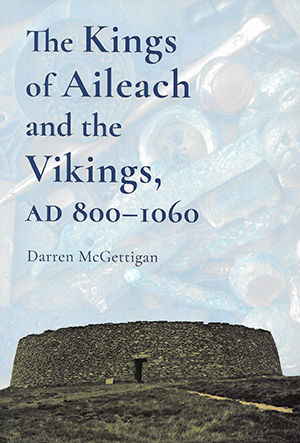THE KINGS OF AILEACH AND THE VIKINGS, AD 800–1060
Published in Book Reviews, Book Reviews, Issue 4 (July/August 2020), Reviews, Volume 28DARREN McGETTIGAN
Four Courts Press
€24.95
ISBN 9781846828362
Reviewed by Seán Duffy
Seán Duffy is Professor of Medieval Irish and Insular History at Trinity College, Dublin.
 Readers will know that there are four provinces in Ireland—Ulster, Munster, Leinster and Connacht. Many will also know that the Irish for ‘province’ is cúige—hence we say Cúige Uladh, Cúige Mumhan, Cúige Laighean, Cúige Chonnacht—but that the word cúige means ‘a fifth’, and so at some stage there must have been five provinces. When scholars go looking through the historical records of early medieval Ireland, however, they find that, more often than not, there were about seven kingdoms that could be classified as provinces. Of these, medieval Munster, Leinster and Connacht had at least some of the same boundaries as their modern equivalents, but others have changed radically or been swept aside by historical events.
Readers will know that there are four provinces in Ireland—Ulster, Munster, Leinster and Connacht. Many will also know that the Irish for ‘province’ is cúige—hence we say Cúige Uladh, Cúige Mumhan, Cúige Laighean, Cúige Chonnacht—but that the word cúige means ‘a fifth’, and so at some stage there must have been five provinces. When scholars go looking through the historical records of early medieval Ireland, however, they find that, more often than not, there were about seven kingdoms that could be classified as provinces. Of these, medieval Munster, Leinster and Connacht had at least some of the same boundaries as their modern equivalents, but others have changed radically or been swept aside by historical events.
By the seventh century, the north midlands of Ireland—containing that most evocative of all Irish landmarks, Tara—comprised a provincial kingdom now long gone. Called Mide, which literally means ‘the middle’, it has given us the names Meath and Westmeath, though it also contained parts of what are now counties Longford and Offaly and stretched all the way from the Shannon to the Irish Sea. The emergence of this powerful midlands kingdom meant that the medieval province of Leinster was confined to the south-east and ran no further north than the Liffey.
But the fortunes of Ulster were more complicated still. The saga literature of early medieval Ireland, including epic tales such as Táin Bó Cúailgne, envisaged an Ulster, ruled from Emain Macha near Armagh, that was, in extent, not a million miles removed from the modern province (albeit that, while it might include what is now County Louth, Cavan was always traditionally part of Connacht). Nevertheless, the political reality for most of the early Middle Ages was quite different from this imagined world of literature, and Ulster—the kingdom of a people called the Ulaid—was a far more restricted entity, comprising not much more than the modern Antrim and Down.
West of Lough Neagh and the upper and lower Bann stretched the now-lost kingdom of Airgialla (Oriel), and beyond that again, all the way to the Atlantic in what is now Donegal, there existed a greater kingdom still that has likewise vanished from view—the kingdom of Ailech, the subject of the latest of Darren McGettigan’s regular outings from Four Courts Press.
The name Ailech was given to the kingdom as a form of symbolic association, in the same way that the ruler of Munster might be called ‘king of Cashel’ or the ruler of Connacht appears in literature as ‘king of Crúachu’ (Rathcroghan, Co. Roscommon). These were their provinces’ royal ceremonial complexes and that is what Ailech represented for the north-west. Oddly enough, though, we are not absolutely certain where this great symbolic site was located. Most think that medieval Ailech was the great stone fortress of Grianán Ailigh at the entrance to the Inishowen peninsula (and this is what McGettigan believes, the site even featuring on the book’s cover), but some have suggested that Ailech lies beneath the remains of the late medieval Elagh Castle (in the townland of Elaghmore—Aileach Mór in its modern Irish form), slightly further east of the Grianán, overlooking Derry City.
The actual territory over which the king of Ailech ruled was called In Tuaiscert and sometimes In Fochla, both of which mean ‘the North’. Its ruling dynasty was called Uí Néill in Tuaisceirt, ‘the Uí Néill of the North’, or ‘the northern descendants of Niall’, a people who claimed descent from the legendary figure of Niall Noígiallach, ‘Niall of the Nine Hostages’. Incidentally, it is misleading to translate this dynastic name as ‘the O’Neills’ (as genealogical websites often do). The later O’Neills of Ulster actually acquired their name from another Niall, a man called Niall Glúndub, the high-king of Ireland who died in 919. His grandson was Domnall ua Néill, literally ‘Domnall grandson of Niall’, but—presumably out of family pride—the name then became fossilised, so that even Niall Glúndub’s great-grandsons and great-great-grandsons continued to call themselves Ua Néill, here meaning ‘descendant of Niall’, and hence the surname O’Neill was born, one of the oldest Irish surnames and, indeed, one of the oldest surviving surnames in the world.
When Niall Glúndub died in 919, it was at the battle of Islandbridge in a war against the Vikings of Dublin, and this book delineates in chronological form the long story of relations between Niall’s dynasty and the Hiberno-Scandinavians. It is not a history of the kingdom of Ailech as such and, covering a period of 260 years in 155 pages, inevitably the coverage cannot be as deep as one might wish for, but it is an interesting story well told. Specialists will not find that it challenges many of their core beliefs and it is a cat that will not distress too many pigeons. Nevertheless, the proverbial educated layperson and enthusiastic undergraduate will enjoy it, learn from it and hopefully, as a result, be motivated into venturing deeper into the extraordinary world of the kings of Ailech in the Viking Age.
















